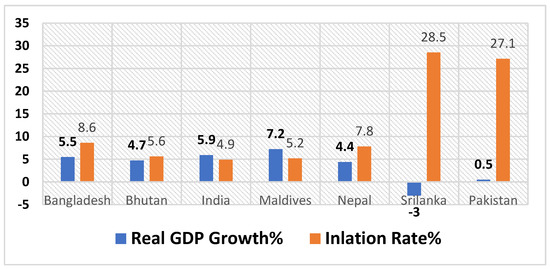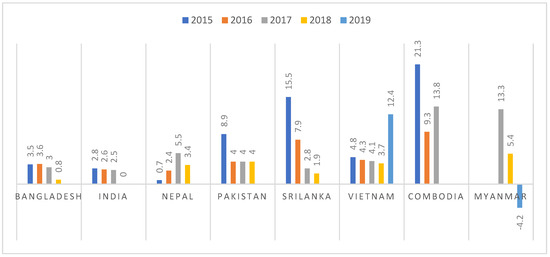Internationalization has become increasingly important to the competitiveness of firms of all sizes, including small and medium-sized enterprises (SMEs). SMEs play a crucial role in the development of lower-income countries. Firm internationalization, which refers to the increasing involvement of organizations in international markets, is a key instrument for companies seeking global horizontal integration and developing countries seeking to ensure the long-term viability of their development in various manufacturing and service sectors. As barriers to internationalization gradually rescind, firms in developing countries recognize that competing globally is no longer a choice but a necessity.
- SMEs
- Bangladesh
- developing countries
- Uppsala model
- firm internationalization
1. Introduction


2. Firm Internationalization
3. Developing Countries
4. Uppsala Model
5. Technological Capabilities
This entry is adapted from the peer-reviewed paper 10.3390/su151511654
References
- IMFa. World Economic Outlook, Database. 2023. Available online: https://www.imf.org/en/Publications/WEO/weo-database/2023/April/groups-and-aggregates (accessed on 15 July 2022).
- IMFb. IMF Country Information. April 2023. Available online: https://www.imf.org/en/Countries (accessed on 15 July 2022).
- World Bank. CountryProfile. DataBank|The World Bank. 2023. Available online: https://databank.worldbank.org/views/reports/reportwidget.aspx?Report_Name=CountryProfile&Id=b450fd57&tbar=y&dd=y&inf=n&zm=n&country=BGD (accessed on 15 July 2022).
- ILO. Wages and Working Time Statistics (COND Database). ILOSTAT. 2020. Available online: https://ilostat.ilo.org/resources/concepts-and-definitions/description-wages-and-working-time-statistics/ (accessed on 15 July 2022).
- Fjose, S.; Grunfeld, L.; Green, C. SMEs and Growth in Sub-Saharan Africa. Oslo: MENON Business Economics. 2010. Available online: https://tinyurl.com/5ccdx63c (accessed on 15 July 2022).
- De Kok, J.; Deijl, C.; Essen, C.V.-V. Is Small Still Beautiful? Literature Review of Recent Empirical Evidence on the Contribution of SMEs to Employment Creation; GIZ: Eschborn, Germany; ILO: Geneva, Switzerland, 2013; Available online: https://www.ilo.org/employment/Whatwedo/Publications/employment-reports/WCMS_216909/lang--en/index.htm (accessed on 15 July 2022).
- Criscuolo, C.; Gal, P.N.; Menon, C. The Dynamics of Employment Growth: New Evidence from 18 Countries, OECD Science, Technology and Industry Policy Papers, No. 14. 2014. Available online: https://www.oecd-ilibrary.org/science-and-technology/the-dynamics-of-employment-growth_5jz417hj6hg6-en (accessed on 15 August 2022).
- World Bank. World Development Indicators 2014. International Bank for Reconstruction and Development; World Bank: Washington, DC, USA, 2014; Available online: https://data.worldbank.org/ (accessed on 15 July 2022).
- Simu, T.H.; Chowdhury, M.A. Comparative Analysis of SME Policy: The Takeaway for Bangladesh. Small (Service) 2019, 100, 50.
- Arregle, J.L.; Naldi, L.; Nordqvist, M.; Hitt, M.A. Internationalization of family-controlled firms: A study of the effects of external involvement in governance. Entrep. Theory Pract. 2012, 36, 1115–1143.
- OECD. The OECD Principles of Corporate Governance; Contaduría y Administración; OECD Publications Service: Paris, France, 2004; p. 216.
- Wilson, K. Encouraging the internationalization of SMEs. OECD Pap. 2006, 6, 43–66.
- Arthur, S.; Sheffrin, S.M. Economics: Principles in Action; Prentice Hall: Hoboken, NJ, USA, 2003; Volume 7458, p. 173.
- Kyvik, O.; Saris, W.; Bonet, E.; Felício, J.A. The internationalization of small firms: The relationship between the global mindset and firms’ internationalization behavior. J. Int. Entrep. 2013, 11, 172–195.
- Ariyo, D. Small Firms Are the Backbone of the Nigerian Economy 2008. Africa Economic Analysis. Available online: http://www.africaeconomicanalysis.org/articles/gen/smallhtm.html (accessed on 15 July 2022).
- Cyert, R.M.; March, J.G. A Behavioral Theory of the Firm; Prentice-Hall, Inc.: Englewood Cliffs, NJ, USA, 1963; Volume 2, pp. 169–187.
- Aharoni, Y. The foreign investment decision process. In The Foreign Investment Decision Process; Harvard Business School: Boston, MA, USA, 1966.
- Forsgren, M.; Hagström, P. Ignorant and impatient internationalization? The Uppsala model and internationalization patterns for Internet-related firms. Crit. Perspect. Int. Bus. 2007, 3, 291–305.
- Anderson, E.; Gatignon, H. Modes of foreign entry: A transaction cost analysis and propositions. J. Int. Bus. Stud. 1986, 17, 1–26.
- Agarwal, S.; Ramaswami, S.N. Choice of foreign market entry mode: Impact of ownership, location and internalization factors. J. Int. Bus. Stud. 1992, 23, 1–27.
- Håkanson, L.; Kappen, P. The ‘casino model’ of internationalization: An alternative Uppsala paradigm. J. Int. Bus. Stud. 2017, 48, 1103–1113.
- Ojala, A. Geographic, cultural, and psychic distance to foreign markets in the context of small and new ventures. Int. Bus. Rev. 2015, 24, 825–835.
- Johanson, J.; Vahlne, J.E. Commitment and opportunity development in the internationalization process: A note on the Uppsala internationalization process model. Manag. Int. Rev. 2006, 46, 165–178.
- Johanson, J.; Vahlne, J.E. The Internationalization Process of the Firm—A Model of Knowledge Development and Increasing Foreign Market Commitments; Routledge: London, UK, 2017.
- Eriksson, K.; Johanson, J.; Majkgård, A.; Sharma, D.D. Experiential knowledge and cost in the internationalization process. In Knowledge, Networks and Power; Springer: Berlin/Heidelberg, Germany, 2015; pp. 41–63.
- Wang, Y.; Lo, H.P.; Zhang, Q.; Xue, Y. How technological capability influences business performance: An integrated framework based on the contingency approach. J. Technol. Manag. China 2006, 1, 27–52.
- Kang, T. An empirical study on the determinants of export performance: Astudy of small and medium-sized Gwagju-Cheonnam manufacturing firms in Korea. J. Int. Bus. 2004, 15, 1–28.
- Kuivalainen, O.; Puumalainen, K.; Sintonen, S.; Kyläheiko, K. Organizational capabilities and internationalization of the small and medium-sized information and communications technology firms. J. Int. Entrep. 2010, 8, 135–155.
- Lee, C.; Lee, K.; Pennings, J.M. Internal capabilities, external networks, and performance: A study on technology-based ventures. Strateg. Manag. J. 2001, 22, 615–640.
- Esteve-Pérez, S.; Rodríguez, D. The dynamics of exports and R&D in SMEs. Small Bus. Econ. 2013, 41, 219–240.
